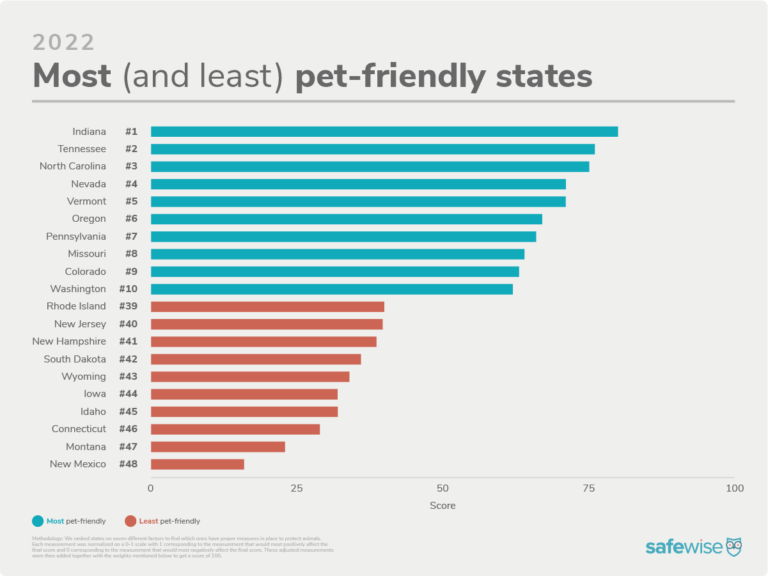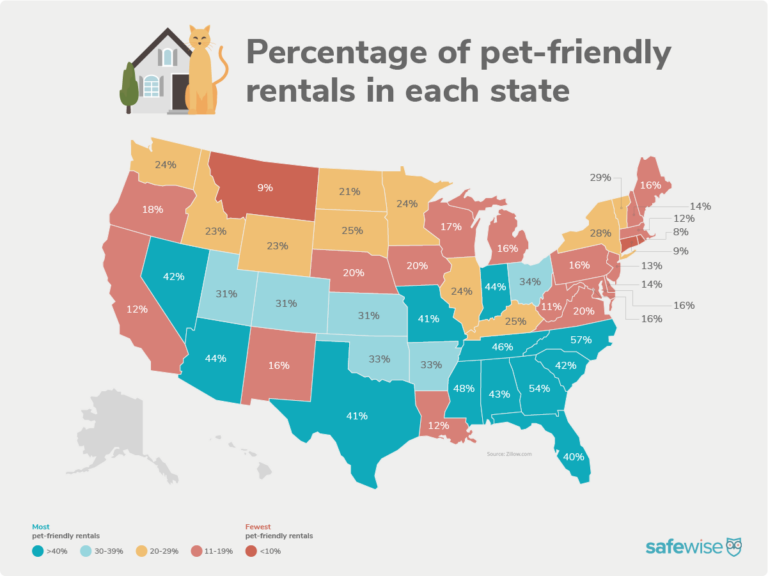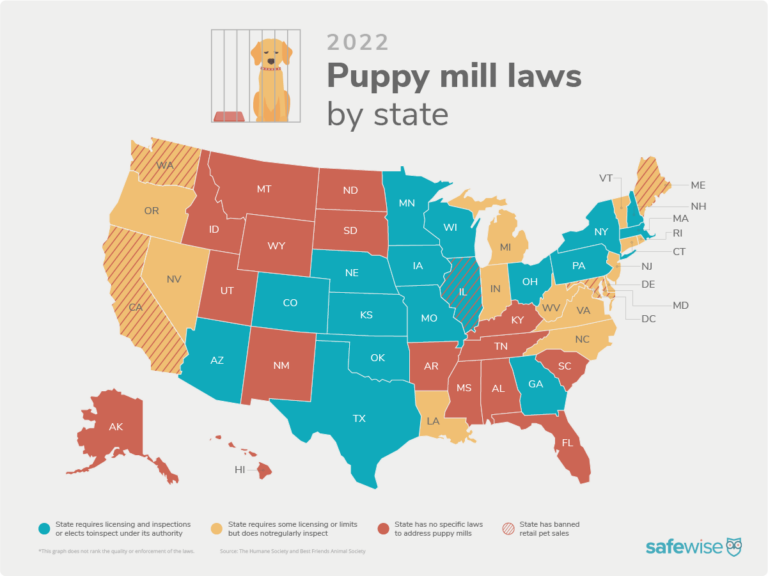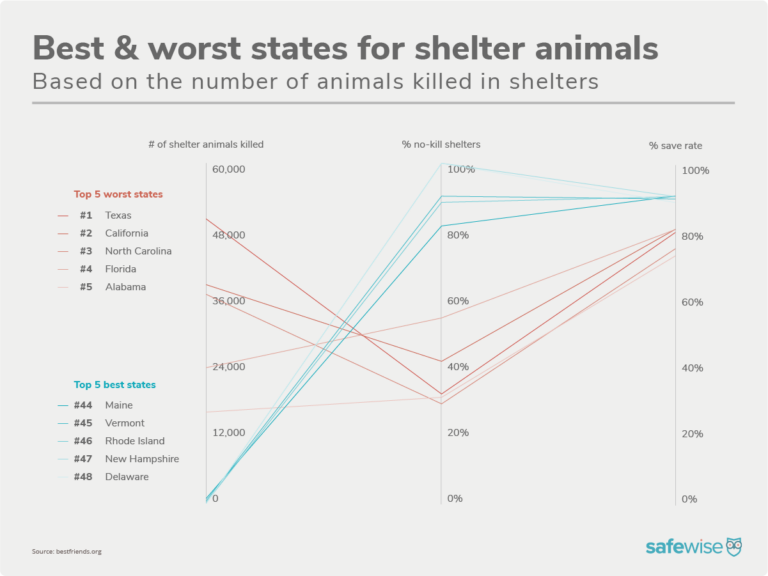In the US, there are over 50,000 pet-friendly rentals and more than 71 million households with pets.1,2 But where can you live that puts the safety of pets at the forefront?
To help folks looking to find a place to call home for themselves alongside their furry friends, we’ve highlighted the most (and least) pet-friendly states. We ranked according to pet population, rentals that allow pets, and laws that protect pets and prevent abuse.
To see our full state rankings, jump below.
How we ranked the pet-friendly states
We based half of our ranking on how easy it is for you and your pet to find a place to live alongside other pet-owning neighbors. In the other half of our weights, we considered which states had laws demonstrating compassion for pets and acting against animal abuse.
We ranked states on the following:
- Percentage of pet-friendly apartments (30%)
- Pet population (20%)
- Pets-left-in-car laws (10%)3
- Veterinary reporting requirement law (10%)4
- Tether law (10%)5
- Anti-cruelty and sexual assault laws (15%)6,7
- Animal fighting paraphernalia law (5%)8
*Note: We omitted Alaska and Hawaii because not all data points were available. See our animal ranking-factor or law overview sections for more information.
See our full methodology for more information and insight on these ranking factors.
We’ll also go over other considerations like travel, shelters, and pandemic concerns that didn’t impact our ranking requirements but may be helpful for all the pet parents out there.
Whether you’re looking for ways to perk up your local pet community, or you’re finding a new home for you or your furry friends, let’s look at the most pet-friendly states in America.
The 10 most pet-friendly states
Where’s the most dog-friendly place to live? Indiana ranks as the most pet-friendly state with a high pet population of 69.2%. Plus, nearly half (44.0%) of its apartments are pet-friendly. Indiana also has almost all of our “must-have” pet laws in place (aside from veterinary reporting requirements, which half of all the states lack too).
You’re also likely to find a fine place for you and your furry friends in Tennessee, North Carolina, Nevada, and Vermont, which all have plenty of pets among the population, a fair amount of pet-friendly rentals, and protective pet laws.
The 10 most pet-friendly states in America in 2022
Rank | State | Score
|
| 1 | Indiana | 80.23
|
|---|
| 2 | Tennessee | 75.99
|
|---|
| 3 | North Carolina | 75
|
|---|
| 4 | Nevada | 71.71
|
|---|
| 5 | Vermont | 71.69
|
|---|
| 6 | Oregon | 66.87
|
|---|
| 7 | Pennsylvania | 66.35
|
|---|
| 8 | Missouri | 63.91
|
|---|
| 9 | Colorado | 63.62
|
|---|
| 10 | Washington | 62.86 |
|---|
- Each of the top 10 pet-friendly states has a pet population percentage of 59% or more. Hopefully, that makes it easier for you and your pup to find a pack to roll around with.
- At number six overall, Oregon ranks for the highest pet population in the top 10 at 70%. Wyoming, which ranks number 43 overall, has the highest pet population percentage in the US at 71.8%.
- Ranking at number three overall, North Carolina has the highest percentage of pet-friendly apartments in the US (56.8%), followed by Georgia (53.5%).
- Despite having plenty of pet-friendly apartments, Georgia ranks much lower at number 31 due to its lack of protective pet laws.
- Pennsylvania has the lowest percentage of pet-friendly apartments in the top 10 at only 15.7%. However, Pennsylvania has a high pet population, checks off all of our “must-have” pet laws, and ends up ranking number 7 overall.
These states all have plenty of pets roaming around, a decent percentage of pet-friendly apartments, and animal safety laws that make it easier to own and protect dogs, cats, and other critters. Unfortunately, not every state makes pet ownership and animal protection a priority, as you’ll see in the lowest ranking states.
The least pet-friendly states
What makes a place the least pet-friendly place to live? A lower pet population, along with rentals that don’t allow pets, means fewer furry friends running around, and they’re less likely to be welcomed. And if animals don’t have legal protection, a state is less likely to prevent or bring justice to animal-related crimes.
Despite having a higher pet population percentage of 60.1%, New Mexico lacks all of our “must-have” pet laws, and only 15.9% of its available rentals are pet-friendly—that’s just over half the national average of 26.2%
Because of this, New Mexico may be the last place on your list of potential places to move with your pet—along with states like Montana, Connecticut, Idaho, and Iowa, which all have lower percentages of rentals and lack some of our desired pet protection laws.
The 10 least pet-friendly states in America in 2022
Rank | State | Score
|
| 48 | New Mexico | 16.12
|
|---|
| 47 | Montana | 23.4
|
|---|
| 46 | Connecticut | 29.2
|
|---|
| 45 | Idaho | 32.56
|
|---|
| 44 | Iowa | 32.75
|
|---|
| 43 | Wyoming | 34.08
|
|---|
| 42 | South Dakota | 36.06
|
|---|
| 41 | New Hampshire | 38.81
|
|---|
| 40 | New Jersey | 39.9
|
|---|
| 39 | Rhode Island | 40 |
|---|
If you’re a pet owner living in one of these states, it may be time to advocate for the changes necessary to make pets feel more at home.
- The states with the lowest percentage of pet-friendly rentals were Rhode Island (7.8%), Connecticut (9.1%), and Montana (9.3%).
- Each of the least pet-friendly states has less than 25% of pet-friendly rentals available, which isn’t too far from below the 26.2% average.
- A total of nine states have pet population percentages of less than 50%: Rhode Island, South Dakota, New Jersey, Maryland, Illinois, Massachusetts, New York, and Connecticut.
- Wyoming has the highest pet population, but only 22% of its apartments are pet-friendly. It also lacks most protective pet laws, except for anti-cruelty laws.
Our rankings don’t reflect the spirit of kind-hearted people in these states or the lengths they’re willing to go through for their furry friends, but they do indicate what sort of legal or housing problems you may face.
We’ll go over the specifics of our rankings below and then provide more insight and tips about pet safety in the US.














